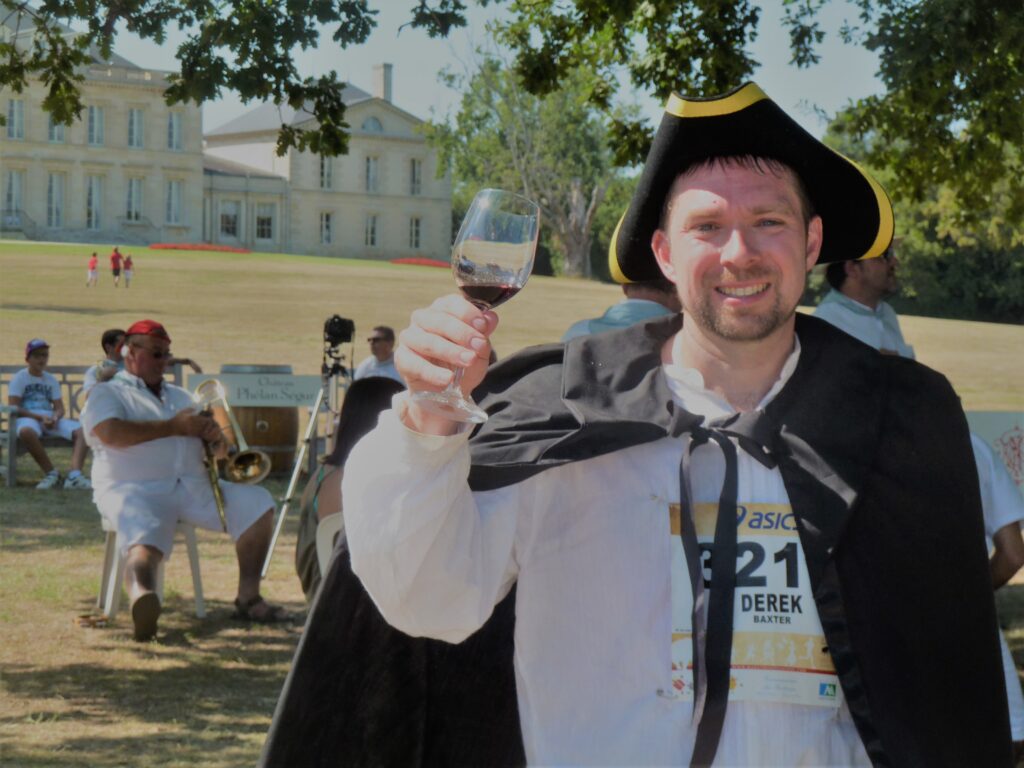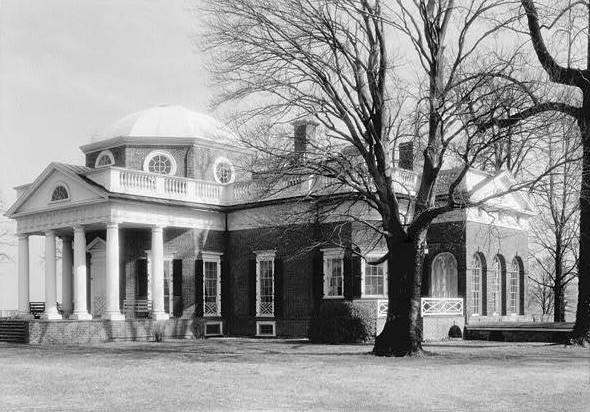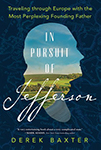Thomas Jefferson is famous for many things, but writing a travel guidebook to Europe doesn’t usually make the list. In 1788, though, he did just that, in the form of a 5,000-word letter to two young acquaintances who wanted his recommendations. Jefferson’s Hints to Americans Travelling in Europe drew on the future president’s experiences on the continent. More than 200 years later, it also helped inspire a new travelogue, In Pursuit of Jefferson: Traveling Through Europe with the Most Perplexing Founding Father, which is just out from Sourcebooks. The Statesider‘s Doug Mack talked to the author, Derek Baxter, about the book and his journeys in the footsteps of one of the nation’s most famous historical figures. This interview has been lightly edited for length and clarity.
I know every interviewer asks this of every author, but I think it’s a useful starting point, so … Where did your interest in Thomas Jefferson begin, and how did it lead to this book?
Thomas Jefferson is very present here in Virginia. I played him in the fourth-grade class play. I went to the school he founded, the University of Virginia. I saw him as my favorite founder because he seemed like he could do everything. He could write brilliantly in the Declaration of Independence and invent things and play the violin. He just seemed like the kind of person I wanted to be.
When I reached my late thirties, I felt that maybe my life was, in a way, getting a little quiet. It wasn’t quite what I had envisioned it or, you know, maybe I was missing out on some things that I had really enjoyed, especially travel—I had previously done some backpacking through Europe, but now I was set in a career that didn’t really involve travel and it like part of me was missing and, and maybe some of the creative side of me was missing. I was kind of looking for a challenge when I came across this guide that Thomas Jefferson had written. And it just seems to speak to me like, well, here is something I could do. And so, over a few years, mostly with my family but occasionally solo, I took these trips and actually followed this guy just to see what would happen.

It sounds like you had a lot of fun. I mean, especially at the beginning of the book, you’re running in costume through vineyards or you’re talking about Jefferson smuggling rice back into the USA.
Right. It was mostly fun throughout. The first trip that you mentioned was, was maybe the craziest one. It was this marathon that they run in Bordeaux, where people run in costume and you actually get to drink wine along the way. That was one of the things in Jefferson’s guide: go to Bordeaux and try the wine there. It seemed like this was kind of like a great way to get in there and see it. This was 2012 and the theme that year was history, which also seemed to me like a bit of a sign in a way because I think that’s the only time they’ve had that particular theme. So I thought, okay, they’re not going to give me any side-eye if I’m dressed as Jefferson. My wife and I went and we ran and it was amazing — it was a fun time, but it also gave me the sense, like, okay, this is a good idea. I think we should, we should continue.
Yeah, it’s a great scene of you lining up with some Romans and Napoleon. It just gets you right into the mood. At that point, were you thinking book or were you just thinking this would be a fun activity to do?
Not necessarily a book. I did take notes and I was trying to record my impressions and I wanted this to be a transformative experience, but I wasn’t thinking about it as a big, elaborate book—but that grew on me as I did more trips. I was learning things and I wanted to share them.
The book is fairly light at the beginning, but it does get into some more serious themes later. There’s a poignant line about being at Monticello and seeing “a brick with a handprint left in it: the marker of an enslaved artisan’s humanity, fingers splayed in the read clay, frozen in time.” This chapter is clearly a tonal shift in the book, and you handled it beautifully. Can you talk a little bit about how you were experiencing that shift in perspective yourself sort of in that moment or in this accumulation of moments?
Jefferson’s guide talks about many subjects — you know, architecture, agriculture, food and wine, gardens, all these interesting themes that I was learning about and experiencing. But the one thing it doesn’t talk about that was massively important to Jefferson was slavery. Obviously, everybody knows Jefferson was a slave owner and I knew some about that as I started off; I kind of thought at the beginning, well, this is the unfortunate part of Jefferson. But at that point, I didn’t think, “This is going to be a real focus of my journey and of this book,” because this was about his travels and the wine and the architecture. But as I went on, I really did come to understand that slavery was intertwined with everything he did. I mean, this is how he’s paying for his travels and for just about everything — it came mostly came from his tobacco, which was grown and picked and packed by enslaved workers on his plantations.
Jefferson had a government salary as well, but it was really tobacco that paid the bills. And he sold 31 enslaved people while he was in France, because he was in debt. When I learned that, it just really bothered me. When I was traveling in Europe, I kind of spaced these trips out roughly once a year, and the rest of the time I was here in Virginia, and I would take some trips to Monticello, and I would learn more about how he put his ideas into practice. And when you’re there and you learn about architecture and landscaping and all the rest, it was always enslaved people, obviously, who did the work. He was completely reliant on enslaved people for everything.
I started to start to kind of veer off. I start to, first of all, wonder whether this whole project was worth doing and whether it was really worth adding more attention to Jefferson. I had put him on this pedestal, but should he be there? It led to some introspection and eventually I wound up spending a lot more time kind of off the regular itinerary and looking more into the lives of some of the enslaved people who lived at Monticello.

I really appreciate books that balance the serious and the fun. I think the lighter parts help show the depth of humanity, but then they make the really awful things all the clearer and more stark.
Right. There is such a deeper story about how enslaved people weren’t going on the trips with him in Europe, back at the plantations, wondering if Jefferson was ever going to come back from France. If he hadn’t — if he died in some accident over there or something like that — they might have been sold, with mothers separated from children. That happened quite a bit. So, yes, there are lots of moments of joy, but it’s always tempered by this deeper story. And it’s the story that’s kind of been… not hidden, but not fully emphasized in the past.
Throughout the book in these chapters in USA, but also in Europe, you try to capture the sense of place and get into the small details. Can you talk a little bit about how Jefferson brought the ideas of landscape and architecture that he saw in Europe back to the USA and how those travels affected the built environment around him?
Jefferson had read books about landscape garden and about architecture back home, but I think it was very different when he actually got on the road and saw things with his own eyes. So for landscaping, he went to England. Obviously, wasn’t a big fan of the king, but the one thing he loved about England was the gardens, which are very different from the more formal gardens they had at Versailles and other places in France. And that was absolutely what he wanted to do. He visited 19 of these gardens and took very practical notes because he was already thinking about how he could landscape back home.
And at Monticello, he developed this series of roundabout roads, which kind of encircle his mountain through the woods. So there was actually a road that could go just very directly through the farms, straight up to the house, but instead he would prefer to take visitors who were going there for the first time on these, on these roads that would kind of spiral up the mountain through these, these very wild woods. You would emerge and you’d see Monticello at the top of the hill, which is beautiful, of course. And you’d see all these pastures. It was kind of this bucolic vision. And I think he was trying to tell the story about, you know, how he had mastered the mountain and you could look out to the west and see this American land landscape that was out there.
As for the architecture, that was even more influential. The house was half built by both enslaved and free workers. Before Jefferson went to France, Monticello looked totally different than the current Monticello. It didn’t have a dome for one thing, and the design was copied from books, kind of like a paint-by-numbers thing. But then he traveled to Europe and he came back with these French neoclassical ideals. He saw a building in Paris, which you can still see, and he got the idea for the dome. He loved the trend in Paris to make mansions look like they were only one story, even though they were really, say, three stories. So there were little tricks he picked up.
Are there places or things that you wanted to include in the book, but you weren’t able to?
Yeah, I could keep writing this book forever. We had one final trip planned for, it was for the summer of 2020, so you can kind of guess what happened to that one. I traveled to a lot of places that Jefferson went to here in the US, just for background and context for the book.
There were some less obvious ones like the Peaks of Otter, which are these mountain peaks in central Virginia, which Jefferson visited, I think when he was 71. He surveyed the peaks, which kind of just showed that he never gave up on traveling. There are so many other places as well that my family and I went to — Williamsburg, Philadelphia. You can see some historical traces of Jefferson in New York City and throughout new England.
What are the traces in New York City?
So in New York City, he lived on Maiden Lane, which is down in the Wall Street area. And there’s Fraunces Tavern, which is still open as a tavern. I also just like walking around lower Manhattan and seeing Trinity Church and some of the other historic places as you go further uptown.
There’s always one question that we end with at The Statesider: Cake or pie? For you and also for Thomas Jefferson.
I would definitely answer pie for myself. I think Jefferson would’ve gone pie, too. There were a lot of desserts at Monticello. I think they did serve something like an apple custard pie. He loved apples. I think he’d go for some kind of fruit pie.

In Pursuit of Jefferson: Traveling Through Europe with the Most Perplexing Founding Father, by Derek Baxter is available now from Sourcebooks. Pick up a copy now through the Statesider bookshop, which supports local independent booksellers.
